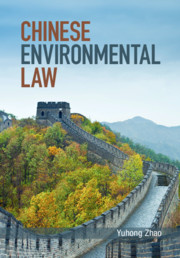Book contents
- Chinese Environmental Law
- Chinese Environmental Law
- Copyright page
- Contents
- Detailed Contents
- Tables
- Preface
- Author’s Note
- Weights and Measures
- Statutes
- Regulations and Measures
- Judicial Interpretations
- State Plans and Party Policies
- Table of Cases
- Table of Treaties
- Abbreviations
- Abbreviations of Legal Instruments
- 1 Environmental Problems and Legal Responses
- 2 Key Institutions of Environmental Protection
- 3 The Environmental Protection Law
- 4 Environmental Impact Assessment
- 5 Regulation and Control of Air Pollution
- 6 Regulation and Control of Water Pollution
- 7 Waste Management
- 8 Soil Contamination
- 9 Environmental Tort
- 10 Judicial Review
- 11 Environmental Crimes
- 12 Environmental Public Interest Litigation
- Bibliography
- Index
12 - Environmental Public Interest Litigation
Published online by Cambridge University Press: 16 June 2021
- Chinese Environmental Law
- Chinese Environmental Law
- Copyright page
- Contents
- Detailed Contents
- Tables
- Preface
- Author’s Note
- Weights and Measures
- Statutes
- Regulations and Measures
- Judicial Interpretations
- State Plans and Party Policies
- Table of Cases
- Table of Treaties
- Abbreviations
- Abbreviations of Legal Instruments
- 1 Environmental Problems and Legal Responses
- 2 Key Institutions of Environmental Protection
- 3 The Environmental Protection Law
- 4 Environmental Impact Assessment
- 5 Regulation and Control of Air Pollution
- 6 Regulation and Control of Water Pollution
- 7 Waste Management
- 8 Soil Contamination
- 9 Environmental Tort
- 10 Judicial Review
- 11 Environmental Crimes
- 12 Environmental Public Interest Litigation
- Bibliography
- Index
Summary
Chapter 12 studies environmental public interest litigation (EPIL) including civil and administrative EPIL that aims to protect the public interest in a sound environment. It expands public participation in environmental governance and strengthens environmental law enforcement by allowing the public and procuratorates to play a more effective role in monitoring and supervising both polluters and agencies. The chapter starts with an examination of standing. That is, who are best suited to file EPIL to guard against environmental pollution and ecological destruction for public interest. It then explores China’s experiments with jurisdiction including the use of specialized maritime courts, newly established environmental tribunals, and jurisdiction by designation. It further analyzes the remedies including injunction of the polluting activities, elimination of harm, cleanup of contamination, compensation for loss of ecological function, compelling agency to perform statutory duties, and declaring agency’s acts or omission being unlawful. The chapter concludes with discussion of judicial mediation and the procedural guarantee to ensure the protection of public interest.
Keywords
- Type
- Chapter
- Information
- Chinese Environmental Law , pp. 392 - 428Publisher: Cambridge University PressPrint publication year: 2021
- 1
- Cited by

